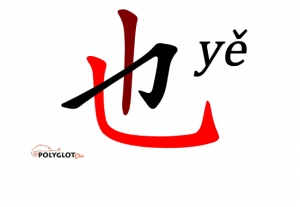Language/Mandarin-chinese/Grammar/也-yě
< Language | Mandarin-chinese | Grammar
Jump to navigation
Jump to search
Rate this lesson:
The adverb 也 <yě> means “too” or “also”.
Like all adverbs in Chinese, 也 <yě> is placed before the verb.
With the completion of this lesson, consider investigating these related pages: 是...的, How to ask a question in Chinese, Questions with 不 (bù) & Questions.
structure[edit | edit source]
Subject + Adverb + Verb + Object
Subject + 也 + Verb + Object
- 他
也是 法國人。/他也是 法国人。 ‹ Tā yě shì Fǎguórén. ›
He is also French.
Other Lessons[edit | edit source]
- 呢 ne
- Transition words
- Express existence with 有 (yǒu)
- Separable verbs
- Time
- 不 (bù)
- 了 le
- Adjectives
- Express possession with 有 (yǒu)
- Ask for directions in Chinese

